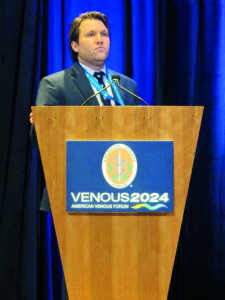
During the 2024 American Venous Forum (AVF) annual meeting in Tampa, Florida (March 3–6), Kurt S. Schultz, MD, a general surgery resident at the Yale University School of Medicine in New Haven, Connecticut, presented data from a study regarding how fasting duration prior to venography is associated with stent size in patients with iliac vein compression. This study was conducted under the mentorship of Cassius Iyad Ochoa Chaar, an associate professor of surgery in the Division of Vascular Surgery and Endovascular Therapy at Yale.
Schultz stated that, while iliac vein stenting is a viable treatment option, “inappropriate sizing of venous stents can have catastrophic complications, and there’s been a rise in reports of stent migration to the heart and lungs. Iliac vein size, as we know, depends on several factors, importantly the hydration status of the patient but also BMI [body mass index] and whether the patient is prone or supine.”
The study that Schultz, Chaar and a multidisciplinary team of colleagues performed divided patients into two groups—those who received their procedures before 11 a.m. (early group) and those who received their procedures after 11 a.m. (late group).
The number of patients in the study was 64, with 30 being in the early group and 34 in the late group. Of the 64 patients, the mean age was 52 years old and 48 patients were female.
Since these patients are typically fasting starting at midnight the day of their surgeries, “patients who are having elective procedures later in the day are likely to be more dehydrated,” Schultz told the audience. “So, our hypothesis was patients undergoing iliac vein stenting later in the day would have smaller stents placed compared to those who had stents placed earlier in the day.”
The study found that later start times, which correlate with longer fasting times and more dehydration, were significantly associated with a smaller stent size compared to procedures performed earlier in the day. “In conclusion, based on our linear regression we found that a nine-hour fasting duration was associated with an approximately 2mm decrease in stent size,” Schultz stated. “So, the longer fasting duration was associated with smaller iliac vein stent size.”
The secondary clinical outcomes supported the hypothesis, with the left common iliac vein and external iliac vein being larger in terms of surface area in the early group when compared with the late group. However, Schultz explained, “this didn’t reach statistical significance.”
Following his presentation, Schultz was asked about whether there were any complications in patients due to the size of the stents. He explained that there have been no stent migrations in the series which would be the rare and feared complication to avoid.
When asked about whether the patients had chronic pain associated with the oversized stents, as there is a larger issue with chronic pain as compared to catastrophic complications such as a stent migration, Schultz responded by saying that his team has the data to look at those complications, adding, “I think that’s an appropriate next step.”
Importantly, Schultz and his team are developing a preprocedural hydration protocol, he concluded.









